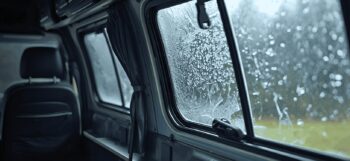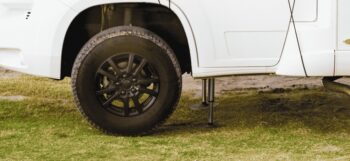None of us would dream of travelling in a car without using a seatbelt, but are we as familiar with the law when it comes to seatbelts and motorhomes? There tends to be some confusion about the legal requirements to use a seatbelt when travelling in a motorhome – in short, they are subject to the same laws as cars as, in the eyes of the law, motorhomes are considered to be a private vehicle. There are no special exemptions for drivers and passengers in motorhomes, however there are some exemptions and conditions which apply to all private vehicle seatbelt laws. In this article, we will give you some more information on what you should (and should not!) do.
It is understandable that there is some confusion relating to the use of seatbelts in motorhomes – did you know that, as recently as 2007, manufacturers did not fit seatbelts outside of the cab as standard? However, all seats are now fitted with seatbelts and it is a legal requirement for them to be worn. There is good reason for this too; just think about what could happen should a motorhome be involved in an accident and flip onto its side. The only exemptions to the seatbelt regulations are as follows;
- A driver who is reversing and has removed their seatbelt temporarily
- A passenger who is supervising a learner driver who is reversing
- Drivers and passengers in an emergency services vehicle, such as an ambulance, fire engine or police car
- A passenger who is investigating a fault in a trade vehicle
- A delivery driver who will be travelling no further than 50 metres between stops
- A licensed taxi driver who is either looking for hires or carrying passengers
- A driver or passenger with a medical exemption. This person will need to obtain a Certificate of Exemption from Compulsory Seatbelt Wearing from their doctor. They must carry the certificate at all times while using a vehicle and must show it to the police if stopped. Motor insurers must also be notified of the exemption.
While older motorhomes, which were produced before the law was changed, are technically legal to use without passenger seatbelts, it is generally frowned upon and best avoided wherever possible (for safety reasons, as much as legal).
If your vehicle does not have seatbelts, the following rules apply;
- You must not carry children under 3 in the vehicle
- Children older than 3 can be carried but must sit in the back
Bear in mind that these laws are only applicable where your vehicle was manufactured prior to the law being changed, for example, a pre-2007 motorhome or a classic car.
When it comes to travelling in a vehicle which does not have seatbelts fitted to all seats, or where the seats are facing sideways, the official Department of Transport advice is:
“Our advice is that passengers are safest in a forward or rearward facing seat equipped with a three-point seat belt. Seat belt anchorage points should be designed so that they will be capable of withstanding the high forces of an impact and seat belts must comply with the latest British or European standards and be marked accordingly with either the ‘e’, ‘E’ or BS ‘Kitemark’. We strongly recommend that they are professionally installed by qualified persons (such as a commercial garage or seatbelt specialist). Although side facing seats, with or without seat belts, are not illegal, we would not advise that they are used. This is because seat belts are not designed to be used with such seats. In the event of an accident, seat belts on these side facing seats may help to prevent the wearer being thrown around the vehicle or from being ejected, but in a frontal crash they can increase injury risk by subjecting vulnerable parts of the body to higher loads than seat belts used on forward facing seats. If you intend to carry children aged 12 years or under, the seat belt wearing regulations require them to use a suitable child restraint. You should bear in mind that child restraints cannot be fitted to side facing seats. In order to fit the required child restraints, you would need to have forward or rearward facing seats with full three-point seat belts.”
Fitting seatbelts to your motorhome
If you currently own a motorhome without all seatbelts and choose to have them fitted, it is important to make sure the job is done correctly. Incorrectly fitted seatbelts can be even more dangerous in the case of an accident than wearing no seatbelt at all.
Seatbelts must be fitted in a way which will qualify for an MOT pass in terms of safety. The decision will come down to the MOT tester on the day, but the following rules must be satisfied:
- Seatbelts must be present for each seat which requires one
- The mounting point and an area of 12” surrounding it must not be damaged or corroded excessively
General points about seatbelts in motorhomes
- Where seatbelts are present, they must be used
- The number of berths declared by the manufacturer does not automatically equal the number of people which can be carried legally when the motorhome is moving
- While passengers can be carried without seatbelts in older motorhomes, it is the driver’s responsibility to make sure it is safe. Passengers not wearing seatbelts pose a risk to themselves and to others, and you may face prosecution in the event of an accident should the police deem the seating arrangement to be unsafe. Your insurer may also refuse to pay out in the event of a claim.
- Passengers must only be carried in a seat which is designated for travel and never in one which is only intended to be used while the motorhome is stationary
- Appropriate child seats must be used when carrying children in a vehicle
The legislation
Should you wish to peruse the full legislation relating to the use of seatbelts, it can be found on the Legislation.gov website.
Travelling in Europe - update December 2014
This is a complicated area!
The use of seat belts in vehicles is compulsory for adults and children unless the vehicle was not fitted with them when it was manufactured. Unfortunately we cannot find any general guidance on side facing seats and have even tried contacting the French Consulate for advice, but to no avail.
However, EC Directive 2005/39/EC does say that all vehicles manufactured after 20th October 2007 must not have side facing seats for travel as it is unsafe, but as legislation cannot be applied retrospectively you theoretically do not need to have the seat belts and can use the seats for passengers should your motorhome have been manufactured prior to this date. One word of caution would be that it is impossible to know how local police will interpret the law.
We would advise that should you wish to travel to Europe, contact your insurance company to make them aware of the situation prior to going as some insurance policies will not cover for passengers not wearing a seat belt.
From a safety perspective, we would not recommend traveling anywhere un-belted with side facing seats and possibly would consider hiring a van that does meet all of the current laws.
Protect your motorhome with great quality insurance from Lifesure. As a broker we have access to a wide range of schemes meaning that we can source the best policy for you and your needs. Call us on 01480 402460 for a no-obligation quote.











